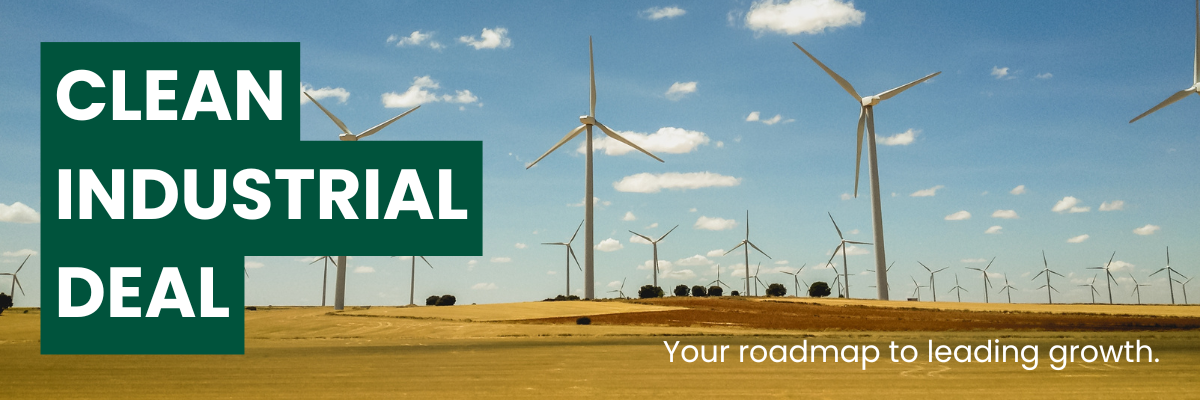
Written by Martijn Meijer
Dear reader,
Welcome to the latest edition of our monthly EU Energy & Climate Policy Update. While Brussels is now emptying out for summer, plenty still happened this past month. Among others, the new EU multiannual budget was presented. In addition, the Commission proposed a plan to support the chemical industry and its long-awaited 2040 climate target.
Europe’s bold plan for sustainable growth, the “Clean Industrial Deal”, represents a major shift for EU businesses, especially in energy-intensive sectors. Don’t miss your chance to engage with the Commission to shape this deal and influence the policy direction for the next five years.

The spotlight
Proposal for the next Multiannual Financial Framework
On 16 July, European Commission President Ursula von der Leyen revealed the proposal for the next Multiannual Financial Framework (MFF), spanning from 2028 to 2034. As the EU’s seven-year roadmap for spending and investment, the MFF shapes everything from climate action to innovation and global partnerships. This latest proposal is for a record-breaking budget of over 2 trillion euros.
The proposal introduces several structural changes that could have significant impacts on businesses and regions across the EU. Curious about what this means in practice? This month’s Spotlight offers a clear snapshot.
What’s in the MFF proposal?
The proposed MFF is in absolute terms far larger than the previous MFF – €2 trillion vs €1.3 trillion (accounting for inflation). However, in terms of Gross National Income, the new budget is 1.15% of GNI, just 0.02% points more than 2021-2027, showing the budget might not be as ambitious as it first seems. Besides from the absolute numbers. its structure is also changing.
The next MFF will bring the number of funding programmes from over 50 funding programmes down to 16, and will include only 4 headings instead of the previous 7. This simplification of the structure is meant to make it easier for organisations and national agencies to find the right funds.
What does it mean for energy and climate?
The energy budget under the Connecting Europe Facility will be increased to €30 billion, while several energy and climate projects can also access the wider Competitiveness Fund, worth over €409 billion euros. This fund will be used, among others, to modernise Europe’s electricity grids, improve network efficiency, and reduce power prices. Energy utilities, grid operators, and technology providers involved in smart grids, battery storage, and grid flexibility stand to benefit from these funds.
Businesses able to offer scalable solutions for digitalised and decentralised energy systems will find themselves in a strong position during the next budget period, as investments are expected to be directed at resolving Europe’s energy cost disadvantage and supply security challenges.
The proposal also includes five new own resources for the EU budget, which are meant to help cover the repayments of EU debt created under the Next Generation EU scheme. This would include a new tax on electrical and electronic equipment that is not collected and recycled, or e-waste.
Although all of this could lead to more funding for energy and climate, how the money will be spent over the course of the budget will be decided on a year-to-year basis. Additionally, with the new embedded flexibility, funds might be shifted around, depending on the year-to-year priorities of the Commission. The new budget would reduce long-term certainty for businesses planning several years in advance.
Next steps
Now that the first part of the Commission’s proposal has been published, it’s up to the European Parliament and the EU Member States, via the Council of the EU, to establish their positions. After the holidays, the Commission will publish the final documents in the proposal on 3 September. Given the many sensitivities involved, from the proposed budget size to the new financial structure, negotiations are expected to take up to two years.
That might sound like a long time, but with 27 Member States involved, and countries such as Germany already voicing objections, 1 January 2028, the start date of the new budget, is approaching faster than it may seem.

Impact analysis for your business
Our free policy updates keep you informed, but is that enough? With our tailored EU Energy & Climate Policy Update you’ll receive:
- Custom insights on how upcoming policy changes might impact your business;
- Strategic advice from your dedicated policy consultant on how to turn challenges into opportunities;
- Early warnings about key legislative developments.

Policy updates
European energy usage continues to fall
In 2023, energy use in the industry sector dropped by 5.3%, continuing a long-term downward trend, according to a report from Eurostat on 25 July. A major milestone: renewables overtook fossil fuels in the pulp and paper sector for the first time. The services sector also saw a 1.9% decline in energy use. These shifts highlight the EU’s progress in decarbonising industry and services while boosting efficiency and competitiveness. In short, the EU is making solid progress toward a cleaner, low-emission future – an essential part of the Clean Industrial Deal, as highlighted in the Commission’s latest update report.
EU and China release joint statement on climate
On 24 July, European Commission President Ursula von der Leyen met with Chinese President Xi Jinping in Beijing for the EU-China Summit. While key differences remained unresolved and no joint communiqué was issued, both sides released a joint climate statement. Amid growing global instability, the EU and China committed to strengthening cooperation on climate action, reaffirming support for the Paris Agreement as the foundation of international climate efforts and pledging to work together toward ambitious, fair, and inclusive outcomes at COP30 in Brazil. The EU secured a modest outcome, falling short of expectations.
European Commission publishes Chemical Package
Big news from Brussels for the chemical industry: on 8 July, the European Commission presented its long-awaited Chemicals Package. It includes two key parts: a new Action Plan for the chemical industry and an Omnibus Package. The Action Plan includes plans for a Critical Chemicals Alliance, which will define criteria for identifying essential molecules and production sites by the end of 2025. An EU-wide inventory is expected in 2026.
Additionally, the Omnibus Package aims to simplify and digitise various legislations, including the Classification, Labelling and Packaging of Chemicals (CLP) Regulation, aiming to relieve European industry of excessive administrative burdens.
EU launches Hydrogen Mechanism under the Energy and Raw Materials Platform
On 2 July, the European Commission launched the Hydrogen Mechanism: its first move under the new EU Energy and Raw Materials Platform to boost the renewable and low-carbon hydrogen market. Aimed at strengthening industrial competitiveness and supply security, the platform helps businesses efficiently source hydrogen and its derivatives like ammonia, methanol, and eSAF. Companies can now register, with the first demand-supply matching scheduled for September 2025.
Denmark takes over Presidency of the Council of the EU
Under the motto “A strong Europe in a changing world,” Denmark took over the Presidency of the Council of the EU on 1 July 2025 from Poland, prioritising energy security, clean industrial growth, and a green transport transition. Key energy priorities include revising the Energy Taxation Directive, setting the 2040 climate target (see Clean Industrial Deal), continuing REPowerEU, and pushing the Industrial Decarbonisation Act. On transport, Denmark aims to advance green freight and passenger mobility, modernise vehicle inspection rules, and finalise cross-border rail and air passenger rights. The Presidency runs until 31 December 2025, when Cyprus takes over.

Clean Industrial Deal
2040 climate target
On 2 July 2025, the European Commission proposed an amendment to the European Climate Law (Regulation EU 2021/1119), which would set a legally binding EU-wide target to cut net greenhouse gas emissions by 90% by 2040, compared to 1990 levels.
The target combines emissions reductions with increased focus on carbon removals, using both natural and technological methods.
Key flexibilities include:
- International carbon credits: From 2036, up to 3% of emissions may be offset using high-quality credits aligned with the Paris Agreement.
- Carbon removal technologies: Bioenergy with Carbon Capture and Storage (BECCS) and Direct Air Carbon Capture and Storage (DACCS) will be integrated into the EU Emissions Trading System (EU ETS) to address residual emissions.
- Sectoral flexibility: Overperformance in one sector can balance underperformance in another, promoting cost-effective and socially fair implementation.
Far right in the lead in European Parliament
For years, the far right criticised the EU’s climate agenda from the sidelines. Now, in a surprise move, the Patriots for Europe (PfE) group in the European Parliament seized control of negotiations over the bloc’s 2040 emissions target with MEP Ondřej Knotek (PfE, Czechia) in charge
To curb PfE’s influence, the Greens, S&D, and Renew fast-tracked the process, giving Knotek just one week to report, cutting short his role. The center-right EPP, caught in the middle, had to choose between aligning with centrists or siding with the far right.
Cornered, Knotek proposed scrapping the entire target. Some centrists warned that a watered-down plan might’ve drawn EPP support, highlighting the far right’s growing sway.
Stakeholder’s reactions
- CAN Europe opposes using international carbon credits in the EU’s 2040 climate target, warning it would weaken climate ambition and shift costs abroad. They call for real domestic emissions cuts, strong national targets, and a fossil fuel phase-out. The EU must adopt ambitious, science-based goals to uphold its climate leadership.
- The European Chemical Industry Council (Cefic) supports more flexible, cost-effective pathways to meet climate targets but calls for concrete measures, such as a net-zero product market, essential infrastructure, and a stronger anti-carbon leakage framework, to realistically address residual emissions and ensure industrial viability beyond 2040.
- FuelsEurope urges the adoption of a Strategic Action Plan and a clear, stable regulatory framework to unlock investment, expand the use of international carbon credits for compliance, and ensure domestic carbon removals are fully integrated into the EU Emissions Trading System.
What’s next
Other MEPs can submit amendments to the proposal until early September, ahead of an environment committee vote later that month. If centrist members of the committee agree on a joint position, they can advance a counterproposal for a full parliamentary vote in October. Knotek’s motion to reject the proposal outright is widely expected to fail.

Blog
EU Circular Economy Act: how will it shape the future of the EU and your business?
Curious about the European Commission’s plans for the upcoming Circular Economy Act and how it could affect your business? Check out our latest blog post for insights.
READ MORE





